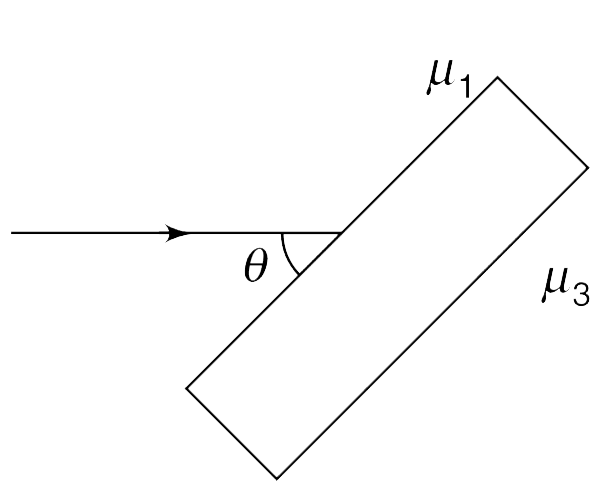Will a ray go undeviating if the medium on both sides of a slab are different?
To determine whether a ray of light will go undeviated when passing through a slab with different refractive indices on both sides, we can analyze the situation step by step.
1. Identify the Slab and Mediums:
- We have a slab with two different mediums on either side. Let’s denote the refractive index of the medium on the left side as n1, the refractive index of the slab as n, and the refractive index of the medium on the right side as n2.
2. Incident Ray:
- A ray of light is incident on the first surface of the slab at an angle i.
3. Refraction at the First Interface:
- When the ray enters the slab from medium n1 (which is less dense) to n (which is denser), it will bend towards the normal. The angle of refraction at this interface can be denoted as r1.
4. Refraction at the Second Interface:
- Now, when the ray exits the slab into medium n2, if n2 is denser than n, the ray will bend towards the normal again. The angle of refraction at this interface can be denoted as r2.
5. Comparison of Angles:
- Since the ray bends towards the normal at both interfaces, it will not maintain its original path. The ray will deviate from its initial direction after passing through the slab.
6. Conclusion:
- Therefore, the ray will not go undeviating when the mediums on both sides of the slab are different. It will experience a deviation due to the change in refractive indices.
Final Answer:
No, the ray will not go undeviating if the medium on both sides of the slab are different.
---
- We have a slab with two different mediums on either side. Let’s denote the refractive index of the medium on the left side as n1, the refractive index of the slab as n, and the refractive index of the medium on the right side as n2.
- A ray of light is incident on the first surface of the slab at an angle i.
- When the ray enters the slab from medium n1 (which is less dense) to n (which is denser), it will bend towards the normal. The angle of refraction at this interface can be denoted as r1.
- Now, when the ray exits the slab into medium n2, if n2 is denser than n, the ray will bend towards the normal again. The angle of refraction at this interface can be denoted as r2.
- Since the ray bends towards the normal at both interfaces, it will not maintain its original path. The ray will deviate from its initial direction after passing through the slab.
- Therefore, the ray will not go undeviating when the mediums on both sides of the slab are different. It will experience a deviation due to the change in refractive indices.
No, the ray will not go undeviating if the medium on both sides of the slab are different.
Topper's Solved these Questions
- REFRACTION OF LIGHT BOOK - CENGAGE PHYSICSCHAPTER - REFRACTION OF LIGHT EXERCISE - MANDATORY EXERCISE (EXERCISE SET II)
27 Videos
- REFRACTION OF LIGHT BOOK - CENGAGE PHYSICSCHAPTER - REFRACTION OF LIGHT EXERCISE - MANDATORY EXERCISE (EXERCISE SET III)
1 Video
- REFRACTION OF LIGHT BOOK - CENGAGE PHYSICSCHAPTER - REFRACTION OF LIGHT EXERCISE - OLYMPIAD AND NSE LEVEL EXCERCISES
10 Videos
- OPTICAL INSTRUMENTS BOOK - CENGAGE PHYSICSCHAPTER - OPTICAL INSTRUMENTS EXERCISE - OLYMPLAD AND NTSE LEVEL EXERCISES
10 Videos
- SOURCES OF ELECTRIC CURRENTBOOK - CENGAGE PHYSICSCHAPTER - SOURCES OF ELECTRIC CURRENTEXERCISE - OLYMPIAD AND NTSE LEVEL EXERCISES
10 Videos
Similar Questions
A light ray travelling in a medium of refractive index μ1 is incident on a parallel faced glass slab making an angle of θ with the glass surface. The refractive index of the medium on the other side of the glass slab is μ3(>μ1). Find the angular deviation suffered by the light ray.

View SolutionA ray of light travelling in air is incident on a composite transparent slab at an angle of incidence i=45°. The composite slab consist of 100 parallel faced slices of equal thickness. The refractive index of the nth slice (counting from the one on which light is incident) is given by μn=1.0+0.01n. The medium on the other side of the slab has refractive index of √2 . Calculate the angular deviation suffered by the ray as it comes out of the slab.
View Solution
Knowledge Check
For a ray to go undeviating where should it pass through?
APrincipal focusBOptical centreCNot possibleDBoth (A) and (B)When a ray of light is going from one medium to another its
Aa wavelength remains sameBb frequency remains sameCc frequency increasesDd wavelength increases
The change in ….................. of light rays while going from one medium to another is called refraction
View SolutionWhat is the difference between a slab and a prism?
View SolutionThe change in ……………. Of light rays whil going from one medium to anoher is called refraction.
View SolutionFill in the blanks and explain the completed sentences.
i. The change in ___ of light rays while going from one medium to another is called refraction.
View SolutionAB and CD are surfaces ot two slabs as shown in Figure . The medium between the slabs has refractive indes 2. Refractive indes of the slab above Ab is √2 and below CD is √3 . Find the minimum angle of incidence at Q, so that the ray is totally reflected by both the slabs.

View SolutionAB and CD are surfaces of two slabs as shown in figure. The medium between the slabs has refractive index 2, refractive index of slab above AB is √2 and below CD is √3. Find the minimum angle of incidence, so that the ray is totally reflected by both the slabs.

View Solution